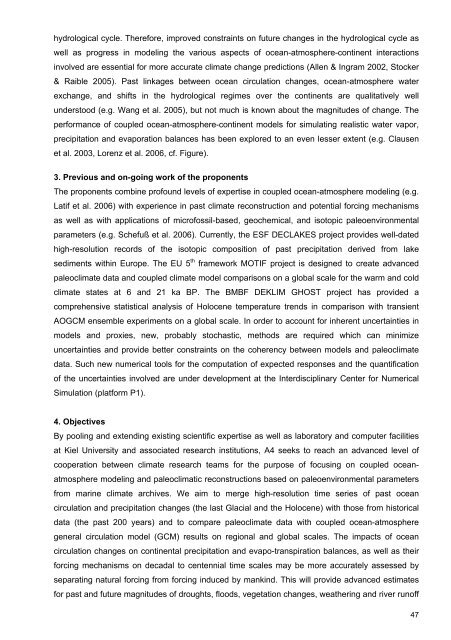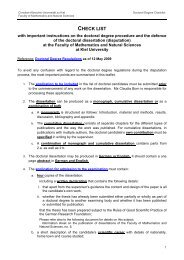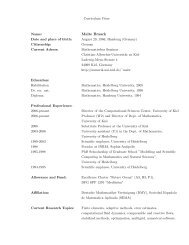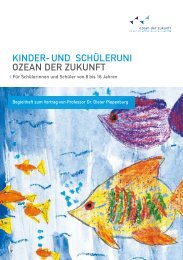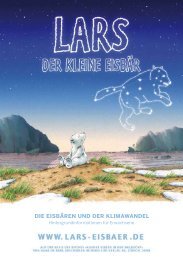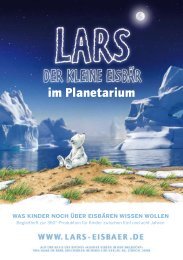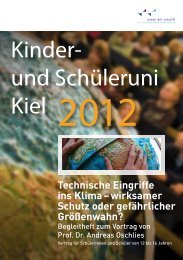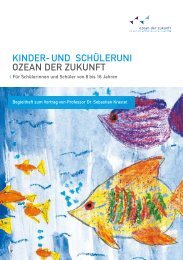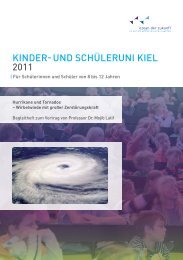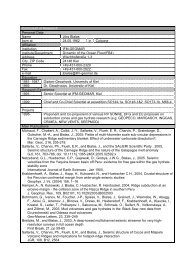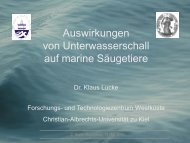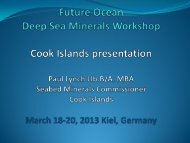hydrological cycle. <strong>The</strong>refore, improved constraints on future changes in the hydrological cycle aswell as progress in modeling the various aspects of ocean-atmosphere-continent interactionsinvolved are essential for more accurate climate change predictions (Allen & Ingram 2002, Stocker& Raible 2005). Past linkages between ocean circulation changes, ocean-atmosphere waterexchange, and shifts in the hydrological regimes over the continents are qualitatively wellunderstood (e.g. Wang et al. 2005), but not much is known about the magnitudes of change. <strong>The</strong>performance of coupled ocean-atmosphere-continent models for simulating realistic water vapor,precipitation and evaporation balances has been explored to an even lesser extent (e.g. Clausenet al. 2003, Lorenz et al. 2006, cf. Figure).3. Previous and on-going work of the proponents<strong>The</strong> proponents combine profound levels of expertise in coupled ocean-atmosphere modeling (e.g.Latif et al. 2006) with experience in past climate reconstruction and potential forcing mechanismsas well as with applications of microfossil-based, geochemical, and isotopic paleoenvironmentalparameters (e.g. Schefuß et al. 2006). Currently, the ESF DECLAKES project provides well-datedhigh-resolution records of the isotopic composition of past precipitation derived from lakesediments within Europe. <strong>The</strong> EU 5 th framework MOTIF project is designed to create advancedpaleoclimate data and coupled climate model comparisons on a global scale for the warm and coldclimate states at 6 and 21 ka BP. <strong>The</strong> BMBF DEKLIM GHOST project has provided acomprehensive statistical analysis of Holocene temperature trends in comparison with transientAOGCM ensemble experiments on a global scale. In order to account for inherent uncertainties inmodels and proxies, new, probably stochastic, methods are required which can minimizeuncertainties and provide better constraints on the coherency between models and paleoclimatedata. Such new numerical tools for the computation of expected responses and the quantificationof the uncertainties involved are under development at the Interdisciplinary Center for NumericalSimulation (platform P1).4. ObjectivesBy pooling and extending existing scientific expertise as well as laboratory and computer facilitiesat Kiel University and associated research institutions, A4 seeks to reach an advanced level ofcooperation between climate research teams for the purpose of focusing on coupled oceanatmospheremodeling and paleoclimatic reconstructions based on paleoenvironmental parametersfrom marine climate archives. We aim to merge high-resolution time series of past oceancirculation and precipitation changes (the last Glacial and the Holocene) with those from historicaldata (the past 200 years) and to compare paleoclimate data with coupled ocean-atmospheregeneral circulation model (GCM) results on regional and global scales. <strong>The</strong> impacts of oceancirculation changes on continental precipitation and evapo-transpiration balances, as well as theirforcing mechanisms on decadal to centennial time scales may be more accurately assessed byseparating natural forcing from forcing induced by mankind. This will provide advanced estimatesfor past and future magnitudes of droughts, floods, vegetation changes, weathering and river runoff47
on longer time scales. <strong>The</strong> latter two aspects will also be important for future biogeochemicalprocesses which control marine biota, as well as air-sea gas and aerosol exchange. To reach thedefined objectives, the JRG will, together with the proponents, (1) apply coupled models whichquantitatively incorporate isotopic and geochemical parameters for past changes in temperatureand precipitation, (2) develop and improve the statistical evaluation of significant regional andbasin-scale climate trends, (3) trace past changes in the hydrological cycle and in natural climateforcing by applying new developments in isotope geochemistry of specific molecular organiccompounds and radionuclides (platform P2).We propose the installation of a JRG as an interdisciplinary team for building additionalcompetence in the development of transient climate modeling from the past into the future incollaboration with research topic A3. Central issues will be the implementation of so-called “proxyparameter” components for ocean circulation and the hydrological cycle in state-of-the-art climatemodels, together with research topics A1, A3, and platform P4. In addition, new statisticaltechniques in paleoclimate proxy data and model comparisons will be developed together withplatform P1. <strong>The</strong> JRG and the proponents will work together preferentially on ocean-atmospherecontinentlinkages via the hydrological cycle and uncertainty/probability indices in ensemble runs ofnumerical simulations. <strong>The</strong> ultimate goal will be to reach a status in which selected climate modelscan quantitatively simulate paleoenvironmental geochemical and isotope proxies representingcirculation, temperature, precipitation, and oceanic CO 2 levels for direct comparison with regionalor global-scale paleoenvironmental proxy data sets. Results generated within A4 will be relevantfor A6, A7, B1 and B5.5. ReferencesAllen MR, Ingram WJ (2002) Contraints on future changes in climate and the hydrological cycle.Nature 419, 224-232.Clausen M, Brovkin V, Ganopolski A, Kubatzki C, Petoukhov V (2003) Climate change in NorthernAfrica: <strong>The</strong> Past is not the <strong>Future</strong>. Climatic Change 57, 99-108.Latif M, Boening C, Willebrand J, Biastoch A, Dengg J, Schneider B, Schweckendiek U (2006) Isthe thermohaline circulation changing? Journal of Climate, in press.Lorenz S, Kim JH, Rimbu N, Schneider RR, Lohmann G (2006) Orbitally driven insolation forcingon Holocene climate trends: Evidence from alkenone data and climate modelling.Paleoceanography 21, PA1002, doi: 10.1029/2005PA001152.Pierrehumbert RT (2002) <strong>The</strong> hydrological cycle in deep-time climate problems. Nature 419, 191-198.Schefuß E, Schouten S, Schneider RR (2005) Climatic controls on central African hydrologyduring the last 20,000 years. Nature 437, 1003-1006, doi: 10.1038/nature03945.Stocker TF, Raible CC (2005) Water cycle shifts gear. Nature 434, 830-833.Wang P, Clemens S, Beaufort L, Braconnot P, Ganssen G, Jian Z, Kershaw P, Sarnthein M (2005)Evolution and variability of the Asian monsoon system: state of the art and outstandingissues. Quaternary Science Reviews 24, 595-629.48
- Page 7 and 8: Contents1 General Information about
- Page 9 and 10: 1 General Information about the Clu
- Page 11 and 12: 1.2 Research Program1.2.1 Summary/Z
- Page 13 and 14: 1.2.2.2 ObjectivesThe Future Ocean
- Page 15 and 16: will address the emerging new resea
- Page 17 and 18: Topics Objectives DisciplinesA1 Exa
- Page 19 and 20: development of these new initiative
- Page 21 and 22: Project Objective IndustryPartnersO
- Page 23 and 24: Continued excellence in the field o
- Page 25 and 26: The establishment of several new po
- Page 27 and 28: 1.4.1 Integrated School of Ocean Sc
- Page 29 and 30: ensure that emerging innovations wi
- Page 31 and 32: Institute / DisciplineAcademic Leve
- Page 33 and 34: their orientation according to the
- Page 35 and 36: 1.7.2 Structural Evolution and Qual
- Page 37 and 38: 30- Notes -
- Page 39 and 40: organisms to elevated CO 2 and decr
- Page 41 and 42: ist wahrscheinlich stärker als wä
- Page 43 and 44: out by the proponents and will esta
- Page 45 and 46: Rückkopplungsschleife weitere Erw
- Page 47 and 48: enthic biota of gas release or the
- Page 49 and 50: Synthese, aufbauend auf einer Kombi
- Page 51 and 52: (4) a determination of the impact o
- Page 53: Einflüsse. Um deren Auswirkungen b
- Page 57 and 58: werden kann. Allerdings sind die ch
- Page 59 and 60: the expertise which already exists
- Page 61 and 62: 2. State-of-the-artThe changing com
- Page 63 and 64: • Field and laboratory investigat
- Page 65 and 66: Erwärmung der Ozeane kann zur Frei
- Page 67 and 68: Valuing the Ocean: Research focus a
- Page 69 and 70: submarine earthquakes, slumps and s
- Page 71 and 72: Fischerei ist eine der wichtigsten
- Page 73 and 74: ecosystems. In particular, the foll
- Page 75 and 76: Hochdurchsatztechnologien die Evolu
- Page 77 and 78: microbial diversity on their barrie
- Page 79 and 80: transient three-dimensional fluid f
- Page 81 and 82: modeling, which describe chemical a
- Page 83 and 84: Erdbeben, submarine Hangrutschungen
- Page 85 and 86: Simons 2003) to investigate shallow
- Page 87 and 88: damit zusammenhängender Meeresspie
- Page 89 and 90: B5(1) Sea-Level Rise and Physical-M
- Page 91 and 92: Pickrill RA, Todd BJ (2003) The mul
- Page 93 and 94: Onate E, Piazzese J (2005) Decision
- Page 95 and 96: echtlichen und ökonomischen Rahmen
- Page 97 and 98: marine resources, such as energy ex
- Page 99 and 100: 92- Notes -
- Page 101 and 102: 2. State-of-the-artThe variety of n
- Page 103 and 104: and will benefit from expertise in
- Page 105 and 106:
Die Plattform 2 stellt die analytis
- Page 107 and 108:
4. New Cluster TechnologiesIn order
- Page 109 and 110:
(iv) Proteomanalysetechniken und (v
- Page 111 and 112:
4. New Cluster TechnologiesA specia
- Page 113 and 114:
Illustration of existing/emerging a
- Page 115 and 116:
physical parameters (e.g. lowered a
- Page 117 and 118:
etabliert, das insbesondere auf wis
- Page 119 and 120:
2.4.3.2 Central Funds for Transfer
- Page 121 and 122:
International School of Ocean Scien
- Page 123 and 124:
Description Year of purchase Amount
- Page 125 and 126:
3.2 Auxiliary Support3.2.1 Total Fu
- Page 127 and 128:
120- Notes -
- Page 129 and 130:
Suess E, Torres ME, Bohrmann G, Col
- Page 131 and 132:
Schreiber, StefanVisbeck, MartinSri
- Page 133 and 134:
4.3 Third-Party FundingNo. FundingB
- Page 135 and 136:
Leibniz Institute of Marine Science
- Page 137 and 138:
These JRG’s will augment the expe
- Page 139 and 140:
The Cluster is embedded in the “K
- Page 141 and 142:
A14- Notes -
- Page 143 and 144:
4.6 Curricula Vitae and Lists of Pu
- Page 145 and 146:
Curriculum of ResearchPersonal Data
- Page 147 and 148:
Curriculum of ResearchPersonal Data
- Page 149 and 150:
Curriculum of ResearchPersonal Data
- Page 151 and 152:
Curriculum of ResearchPersonal Data
- Page 153 and 154:
Curriculum of ResearchPersonal Data
- Page 155 and 156:
Curriculum of ResearchPersonal Data
- Page 157 and 158:
Curriculum of ResearchPersonal Data
- Page 159 and 160:
Curriculum of ResearchPersonal Data
- Page 161 and 162:
Curriculum of ResearchPersonal Data
- Page 163 and 164:
Curriculum of ResearchPersonal Data
- Page 165 and 166:
Curriculum of ResearchPersonal Data
- Page 167 and 168:
Curriculum of ResearchPersonal Data
- Page 169 and 170:
Curriculum of ResearchPersonal Data
- Page 171 and 172:
Curriculum of ResearchPersonal Data
- Page 173 and 174:
Curriculum of ResearchPersonal Data
- Page 175 and 176:
Curriculum of ResearchPersonal Data
- Page 177 and 178:
Curriculum of ResearchPersonal Data
- Page 179 and 180:
Curriculum of ResearchPersonal Data
- Page 181 and 182:
Curriculum of ResearchPersonal Data
- Page 183 and 184:
Curriculum of ResearchPersonal Data
- Page 185 and 186:
Curriculum of ResearchPersonal Data
- Page 187 and 188:
Curriculum of ResearchPersonal Data
- Page 189 and 190:
Curriculum of ResearchPersonal Data
- Page 191 and 192:
Curriculum of ResearchPersonal Data
- Page 193 and 194:
Curriculum of ResearchPersonal Data
- Page 195 and 196:
Curriculum of ResearchPersonal Data
- Page 197 and 198:
Curriculum of ResearchPersonal Data
- Page 199 and 200:
Curriculum of ResearchPersonal Data
- Page 201 and 202:
Curriculum of ResearchPersonal Data
- Page 203 and 204:
Curriculum of ResearchPersonal Data
- Page 205 and 206:
Curriculum of ResearchPersonal Data
- Page 207 and 208:
Curriculum of ResearchPersonal Data
- Page 209 and 210:
A82- Notes -
- Page 211 and 212:
DEKLIMGerman Climate Research Progr
- Page 213 and 214:
ITQ’sISAISOSJRGKCMSKitzLALIFLIMSL
- Page 215 and 216:
WTOWTSHXAFSXRDZMBWorld Trade Organi
- Page 218:
Prof. Dr. Boris Culik • Maritimes
- Page 230:
GMT-Geschäf*sstelleWe"*w{eltJ"*n $
- Page 236:
f,rylheonRaytheon Anschütz GmbHPos


